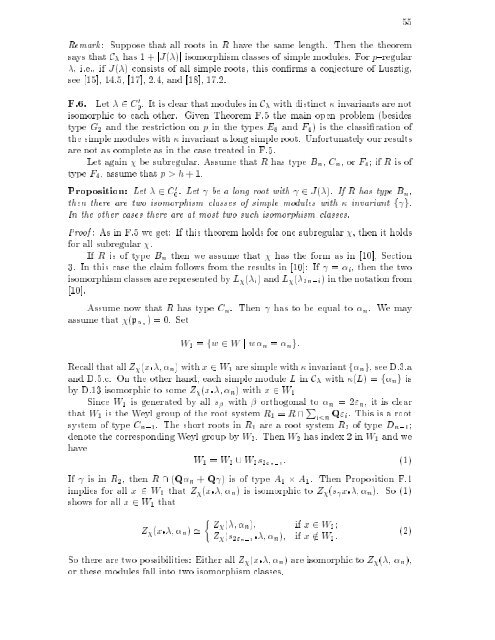subregular nilpotent representations of lie algebras in prime ...
subregular nilpotent representations of lie algebras in prime ...
subregular nilpotent representations of lie algebras in prime ...
You also want an ePaper? Increase the reach of your titles
YUMPU automatically turns print PDFs into web optimized ePapers that Google loves.
Remark: Suppose that all roots <strong>in</strong> R have the same length. Then the theorem<br />
says that C has 1 + jJ( )j isomorphism classes <strong>of</strong> simple modules. For p{regular<br />
, i.e., if J( ) consists <strong>of</strong> all simple roots, this con rms a conjecture <strong>of</strong> Lusztig,<br />
see [15], 14.5, [17], 2.4, and [18], 17.2.<br />
F.6. Let 2 C 0 0 . It is clear that modules <strong>in</strong> C with dist<strong>in</strong>ct <strong>in</strong>variants are not<br />
isomorphic to each other. Given Theorem F.5 the ma<strong>in</strong> open problem (besides<br />
type G2 and the restriction on p <strong>in</strong> the types E8 and F4) is the classi cation <strong>of</strong><br />
the simple modules with <strong>in</strong>variant a long simple root. Unfortunately our results<br />
are not as complete as <strong>in</strong> the case treated <strong>in</strong> F.5.<br />
Let aga<strong>in</strong> be <strong>subregular</strong>. Assume that R has type Bn, Cn, orF4; ifRis <strong>of</strong><br />
type F4, assume that p>h+1.<br />
Proposition: Let 2 C 0<br />
0 . Let be a long root with 2 J( ). IfRhas type Bn,<br />
then there aretwo isomorphism classes <strong>of</strong> simple modules with <strong>in</strong>variant f g.<br />
In the other cases there areat most two such isomorphism classes.<br />
Pro<strong>of</strong> : As <strong>in</strong> F.5 we get: If this theorem holds for one <strong>subregular</strong> , then it holds<br />
for all <strong>subregular</strong> .<br />
If R is <strong>of</strong> type Bn then we assume that has the form as <strong>in</strong> [10], Section<br />
3. In this case the claim follows from the results <strong>in</strong> [10]: If = i, thenthetwo<br />
isomorphism classes are represented by L ( i) and L ( 2n,i) <strong>in</strong> the notation from<br />
[10].<br />
Assume now that R has type Cn. Then has to be equal to n. Wemay<br />
assume that (p n) = 0. Set<br />
W1 = fw 2 W j w n = ng:<br />
Recall that all Z (x ; n) with x 2 W1 are simple with <strong>in</strong>variant f ng, see D.3.a<br />
and D.5.c. On the other hand, each simple module L <strong>in</strong> C with (L) =f ng is<br />
by D.13 isomorphic to some Z (x ; n) withx 2 W1<br />
S<strong>in</strong>ce W1 is generated by alls with orthogonal to n =2"n, it is clear<br />
that W1 is the Weyl group <strong>of</strong> the root system R1 = R \ P i

















